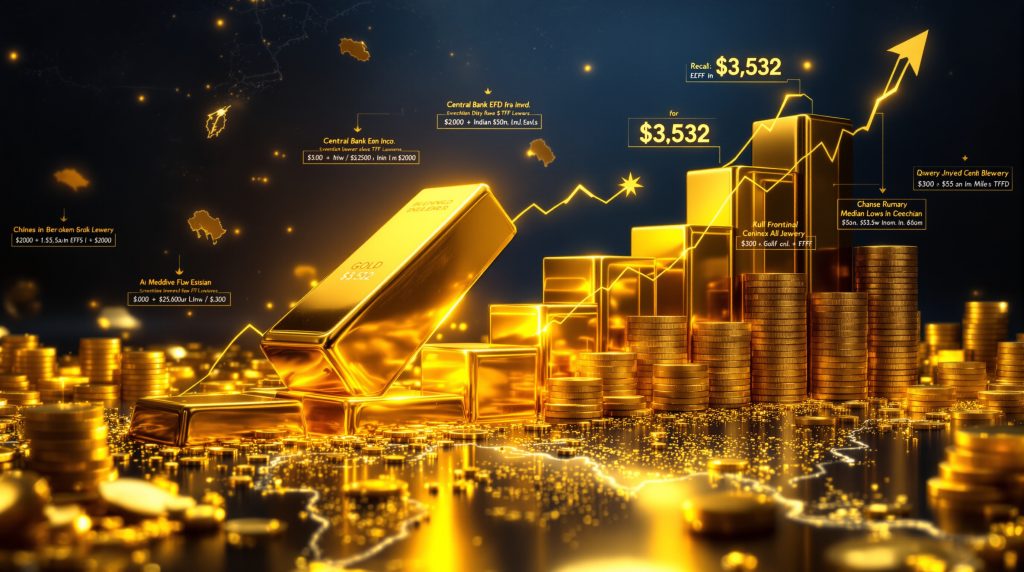Gold's Record-Breaking Rally: What's Driving the Precious Metal to New Heights?
Gold has shattered previous records, reaching an unprecedented $3,532 per ounce in September 2025, marking a remarkable 90% increase since late 2022. This all-time high analysis represents one of the most significant price surges in the precious metal's modern trading history, outpacing inflation and most other asset classes during this period.
The Scale of Gold's Current Bull Market
All-time high: $3,532 per ounce (September 2025)
Percentage gain since late 2022: Over 90%
Previous significant resistance levels broken: $2,000, $2,500, $3,000
Performance comparison: Outperforming major stock indices and most commodities
What's Fueling Gold's Extraordinary Price Surge?
The current gold's record-breaking rally stems from a unique convergence of macroeconomic, geopolitical, and market-specific factors that have created perfect conditions for sustained price appreciation.
Central Bank Purchasing Reaches Historic Levels
Central banks worldwide have dramatically increased their gold reserves, becoming a dominant force in the market:
Annual net purchases exceeding 1,000 metric tons each year since 2022
2025 projected purchases: 900 tons (Metals Focus estimate)
Comparison to previous period: Twice the annual average of 457 tons (2016-2021)
Contribution to total annual gold demand: 23% (2022-2025), double the average share recorded during the 2010s
Geopolitical Tensions and De-Dollarization Trends
International tensions have accelerated the movement toward alternative reserve assets:
Developing nations actively diversifying away from dollar reserves
Western sanctions impact: Approximately half of Russia's foreign currency reserves frozen in 2022
Transparency concerns: Only 34% of 2024 central bank gold purchases officially reported to IMF
Strategic shift: Gold viewed as sanction-proof asset class by emerging economies
How Are Investment Patterns Changing in the Gold Market?
The investment landscape for gold has undergone significant transformation, with institutional and retail investors adjusting their strategies in response to market conditions.
ETF Inflows Surge After Period of Stagnation
Gold-backed exchange-traded funds have emerged as a major demand driver:
| Period | ETF Gold Inflows | Notable Trend |
|---|---|---|
| Jan-Jun 2025 | 397 tons | Largest first-half inflow since 2020 |
| Full-year 2024 | -7 tons (outflow) | Market hesitation before current rally |
| 2025 Projection | 500 tons (net inflow) | Metals Focus forecast |
| Current ETF Holdings | 3,615.9 tons (June 2025) | Highest since August 2022 |
| All-time Record | 3,915 tons (2020) | Current trajectory approaching record |
Retail Investment Shifts Between Product Categories
Physical gold investment has shown resilience despite high prices:
Gold bar demand: 10% increase in 2024
Coin demand: 31% decline in 2024
Net physical investment forecast: 2% rise to 1,218 tons in 2025
Regional strength: Asian markets maintaining robust demand despite price increases
Investor psychology: Positive price expectations fueling continued buying
What Impact Has the Rally Had on Traditional Gold Consumption?
While investment demand has surged, traditional consumption patterns have experienced significant disruption due to record prices.
Jewelry Demand Faces Pressure from High Prices
The jewelry sector, historically the largest source of physical gold demand, has contracted significantly:
Q2 2025 jewelry demand: 341 tons (14% year-over-year decline)
Historical context: Lowest level since Q3 2020 (pandemic-impacted period)
Primary cause: Price sensitivity in major consumer markets
Market share shift: China and India's combined market share fell below 50% (rare occurrence)
Annual fabrication trend: 9% decline to 2,011 tons in 2024, projected 16% further decline in 2025
Regional Variations in Consumer Response
Price sensitivity varies significantly across different gold-consuming regions:
Most price-sensitive markets: India and China (largest traditional consumers)
More resilient markets: Middle East and Southeast Asia
Western markets: Shift from jewelry to investment products
Cultural factors: Traditional wedding and festival demand maintaining minimum consumption levels despite price pressure
What's Behind Western Monetary Policy's Influence on Gold?
Monetary policy decisions, particularly in the United States, have created a favorable environment for gold despite traditionally negative correlations with interest rates.
Federal Reserve Policy Expectations
The market's anticipation of U.S. monetary policy shifts has been a key catalyst:
Rate cut expectations: Markets pricing in multiple Fed rate reductions
Dollar impact: U.S. currency weakening against major trading partners
Real yield effect: Declining real interest rates reducing gold's opportunity cost
Historical pattern break: Gold rallying despite relatively high nominal interest rates
Political Uncertainty and Market Confidence
Political developments have contributed to market anxiety and gold demand:
U.S. policy concerns: Questions about trade relationships and security alliances
Federal Reserve independence: Market worries about political pressure on monetary policy
Fiscal outlook: Growing national debt and deficit concerns
Market sentiment: Increasing hedging activity against policy uncertainty
What Are the Supply Dynamics Supporting High Gold Prices?
While demand factors have dominated the narrative, supply constraints have played a supporting role in maintaining price momentum.
Mining Production Limitations
Global gold mining output has shown limited responsiveness to higher prices:
Annual production growth: Approximately 1% in 2025 despite price incentives
Development timeline challenges: New mines require 5-10 years from discovery to production
Grade decline: Many established mining districts experiencing lower ore grades
Cost inflation: Rising input costs partially offsetting price benefits for producers
Environmental restrictions: Increasing regulatory hurdles for new project approvals
Recycling Response to High Prices
Secondary supply through recycling has increased but not enough to balance strong demand:
Recycling volume increase: 10-15% year-over-year growth in 2025
Historical pattern: Diminishing returns as "easy" scrap sources are exhausted
Quality factors: Declining gold content in many consumer electronics
Regional variations: Strongest recycling response in price-sensitive developing markets
How Are Gold Mining Companies Benefiting from the Rally?
The producer landscape has been transformed by sustained high prices, with significant implications for corporate strategies and investor returns.
Profit Margin Expansion
Mining companies have experienced dramatic financial improvements:
Average all-in sustaining costs (AISC): $1,250-1,350 per ounce
Current profit margins: Exceeding $2,000 per ounce at recent price levels
Free cash flow generation: Multiple major producers reporting record quarterly results
Debt reduction: Accelerated balance sheet improvement across the sector
Dividend increases: Growing shareholder returns from major gold miners
Strategic Shifts in the Mining Sector
High gold prices are changing corporate behavior and industry structure:
M&A acceleration: Increased acquisition activity using appreciated equity
Exploration budgets: Significant increases in discovery-focused spending
Project advancement: Previously marginal developments now economically viable
Reserve calculations: Higher price assumptions increasing official reserve statements
Production decisions: Some producers holding inventory anticipating further price gains
What Are Analysts Forecasting for Gold's Future?
Professional market observers have adjusted their outlooks to account for gold's extraordinary performance and underlying fundamentals.
Price Projections and Potential Catalysts
Expert forecasts suggest continued strength with specific triggers:
Q3 2025 average price forecast: $3,500 per ounce
Q4 2025 average price forecast: $3,700 per ounce
Potential upside catalyst: Accelerated central bank purchasing
Potential downside risk: Faster-than-expected inflation control reducing rate cut expectations
Technical resistance levels: Limited historical reference points above $3,500
Long-Term Structural Considerations
Beyond short-term price movements, analysts identify fundamental shifts supporting elevated gold prices:
Global reserves diversification: Multi-decade trend away from dollar dominance
Debt sustainability concerns: Growing sovereign debt burdens across developed economies
Physical allocation trends: Institutional portfolio managers increasing recommended gold exposure
Production peak theories: Some analysts suggesting global gold mining output may plateau
Technological demand: Emerging industrial applications potentially adding marginal demand
How Does This Rally Compare to Previous Gold Bull Markets?
The current price surge exhibits both similarities and differences compared to previous major gold bull markets.
Historical Context and Unique Characteristics
This rally stands apart from previous cycles in several key aspects:
1970s comparison: Current rally occurring despite absence of double-digit inflation
2008-2011 comparison: Similar safe-haven motivation but stronger central bank participation now
2020 pandemic surge: Current rally more sustained with broader institutional participation
Interest rate environment: Unprecedented strength despite relatively high interest rates
Market participation: More diverse global buying base than previous rallies
FAQs About Gold's Record-Breaking Rally
Will Gold Prices Continue Rising Through 2026?
Most analysts project continued strength in gold prices through 2026, with average forecasts suggesting potential for further records above $3,700 per ounce. Key factors supporting this outlook include anticipated Federal Reserve rate cuts, ongoing central bank purchases, and persistent geopolitical uncertainties. However, potential headwinds include eventual economic stabilization and possible profit-taking after such a substantial historic 3000 surge.
How Are Gold Mining Stocks Performing Relative to Physical Gold?
Gold mining equities have generally outperformed the metal itself during this rally, with the NYSE Arca Gold Miners Index showing amplified returns compared to spot gold. Companies with lower production costs, growing output, and minimal jurisdictional risks have seen the strongest performance. According to recent mining company insights, investor preference has shifted toward larger producers with proven operational track records rather than exploration-stage companies.
What Impact Would a Global Recession Have on Gold Prices?
A global recession would likely accelerate gold's upward trajectory through several mechanisms: central banks would implement more aggressive monetary easing, investors would seek safe-haven assets amid equity market volatility, and government deficit spending would increase sovereign debt concerns. The inflation hedge dynamics suggest gold typically performs strongly during and immediately following recessions, particularly when accompanied by currency devaluation concerns.
How Are Retail Investors Accessing the Gold Market in 2025?
Retail investors have increasingly diversified their gold exposure beyond traditional physical ownership. While coin and small bar purchases remain popular, fractional ownership platforms, gold-backed cryptocurrencies, and low-cost ETFs have dramatically expanded accessibility. Mobile applications offering gold savings plans have been particularly successful in emerging markets, bringing millions of first-time investors into the gold market with minimal entry barriers.
Further Exploration
Readers interested in learning more about gold market trends can also explore related educational content on MINING.com and other industry publications that offer additional perspectives on factors driving the precious metal's historic performance. For those seeking to optimize their portfolios, exploring various investment strategy trends can provide valuable insights as gold's record-breaking rally continues to reshape global financial markets.
Want to Profit from the Next Major Mineral Discovery?
Discover why historic gold discoveries can generate substantial returns by exploring Discovery Alert's dedicated discoveries page, where their proprietary Discovery IQ model delivers real-time alerts on significant ASX mineral discoveries, instantly transforming complex data into actionable insights for investors like you.




